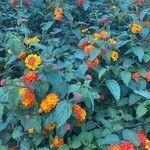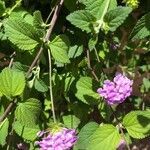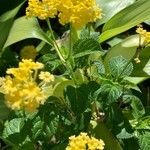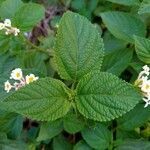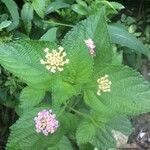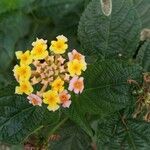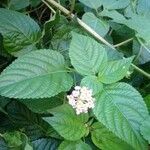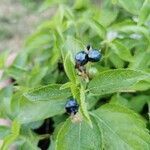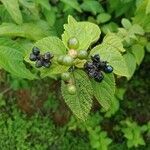Branching shrubs, to 2 m high; stems and branches mostly unarmed or slightly prickly, usually minutely and inconspicuously pubescent. Leaves decussate-op-posite; the blades chartaceous, ovate to oblong-ovate, 2-12 cm long and 2-4.5 cm wide, acute or short-acuminate (rarely obtuse apically), acutely narrowed or abruptly rounded to a subcuneate acumination basally, crenate-serrate, more or less reticulate-rugose and decidedly scabrous or scabrellous above, usually only sparsely pilosulous or strigillose beneath (mostly only on the venation) with canescent or brownish trichomes, sometimes glabrescent; petioles 7-12 mm long. Inflorescences axillary, shorter than, equaling, or surpassing the subtending leaves, the heads always capitate, hemispheric, to 3 cm wide, not elongating after an-thesis, many-flowered; peduncles slender, 2-9 cm long, more or less appressed-pilose or puberulent; bractlets usually not conspicuous, oblong to lanceolate, equal, 4-7 mm long, and 1-1.5 mm wide, subulate or acute, rarely a few larger ones also present, appressed strigose-pubescent,. usually about as long as the corolla-tube. Flowers with the calyx thin, ca. 3 mm long; corolla hypocrateriform, mostly orange-yellow or orange, changing to red or scarlet in age, the tube ca. 10 mm long, barely enlarged above the middle, slightly curved, puberulent, the limb 6-8 mm wide. Drupes fleshy, black, ca. 3 mm in diameter.
Shrub, sprawling or scandent, 1–3 (–6) m high, sometimes forming dense thickets or scrambling shrubs several metres high. Stem ±quadrangular, often with recurved prickles; branches usually not rooting at nodes. Leaves petiolate; petiole 3–25 mm long, glandular hairy; lamina oblong-ovate, 35–120 mm long, 15–80 mm wide, crenately serrate, acute to acuminate, bullate-rugose with coarse tubercle-based hairs above, viscid-tomentose beneath. Inflorescence of capitate hemispheric heads 10–30 mm diam. Flowers many in each capitulum; bracts equisized, linear to narrowly ovate, often 1–2 mm wide, not conspicuously involucrate. Calyx tube 1–2 mm long, glandular-pubescent outside. Corolla variously coloured, pubescent outside; tube curved, inflated above middle, 7–12 mm long; limbs 5–10 mm wide. Stamens inserted above the middle of corolla tube; anthers orbicular. Ovary ellipsoid, glabrous; style 2–3 mm long; stigma oblique. Drupe ellipsoid-globose, enclosed by bracts and calyx, splitting into 2 pyrenes.
Aromatic shrub; stems upright to spreading, or almost scrambling to c. 2-(3) m high, usually with recurved prickles. Petioles to 2 cm long. Lamina 3-13 × 1.5-7 cm, ovate or oblong-ovate, crenate or crenate-serrate, densely hispidulous or scabrid above, the hairs usually dense but soft below; glandular scales minute; base cuneate to subcordate; apex acute to short-acuminate. Infls corymbose; fls fragrant. Peduncles 3-10 cm long, moderately slender; bracts 1/4-3/4 length of corolla tube, linear-lanceolate, densely hairy but eglandular. Calyx 1.5-2.5 mm long, ciliate. Corolla densely puberulent outside; tube c. 1 cm long, narrow-cylindric; limb 6-10-(14) mm diam., when fresh, rather flat except for ± recurved lobes, usually initially cream or pale yellow, changing to pink to rose, rarely deep yellow or orange. Drupe c. 5 mm diam., globular, black or blue-black.
An evergreen shrub. It grows to 3 m high and spreads to 3 m across but under some conditions can be much more spreading and pose problems. The stem is erect and woody at the base. The stem has 4 angles and prickles which curve backwards. The leaves are small and oval. They are 1.5-8.5 cm long by 0.8-6 cm wide. They have a rough surface. The flowers are pale cream and very small. They are arranged in dense heads which are 2.5 cm across. The fruit are berries which turn black when ripe. The ripe fruit are edible. Various cultivated varieties have been produced with attractive coloured flowers. Some of the orange coloured forms are poisonous to animals.
Spreading weed, 0.5-3.0(-5.0) m high; stems 4-angled. Leaves petiolate; broadly ovate to oblong-ovate; 20-120 x 20-70 mm, apex acute, base ± rounded, margins closely crenate-serrate; upper surface scabrid with coarse tubercle-based hairs, rugose, venation impressed; lower surface glabrescent, scabrid on raised venation. Inflorescences: flat heads, 20-30 mm in diam. Flowers orange, red, pink, mauve, pure yellow or white. Calyx thin, obscurely 4-toothed. Corolla: tube slightly curved; limb oblong to rounded. Flowering time Sept.-Apr. Fruit globose drupes; pyrene ovoid.
Shrubs with long weak branches, armed with stout recurved prickles, pubescent. Petiole 1-2 cm, pubescent; leaf blade ovate to oblong, 3-8.5 X 1.5-5 cm, papery, wrinkled, very rough, with short stiff hairs, aromatic when crushed, base rounded to subcordate, margin crenate; lateral veins 5 pairs, very prominent, elevated. Capitula terminal, 1.5-2.5 cm across. Flowers yellow or orange, often turning deep red soon after opening. Ovary glabrous. Drupes deep purple, globose, ca. 4 mm in diam. 2n = 44.
Leaves opposite, petiolate; (3)4–11 × (2)2.8–6(7) cm, broadly ovate to oblong-ovate, acute or ± acuminate at the apex, rounded to broadly or narrowly cuneate at the base or sometimes subcordate, coarsely to closely crenate or crenulate on the margins, scabrid with coarse tubercle-based hairs on the upper surface ± pubescent or glabrescent beneath but scabrid on the raised venation, rugulose with impressed venation above, raised reticulate beneath; petiole 0.7–2 cm long, slender.
Corolla variously coloured, orange, red, pink, mauve, pure yellow or white, often with a yellow or orange centre, young flowers pale changing to a deeper or a different colour with age, sometimes the inner flowers a different colour from the outer; tube 10–12 mm long, narrow in the lower half, widening slightly above, slightly curved, puberulous outside; limb 6–9 mm in diameter, lobes up to 5 mm wide and oblong to rounded.
Stem and branches 4-angled, unarmed to slightly or copiously covered with recurved prickles, ± scabridulous and sparsely to densely hispid or strigose, sometimes with short gland-tipped hairs intermixed on peduncles and branchlets, ± densely sessile glandular towards the end of peduncles and branches.
Shrub, up to 2 m high. Stems and branches prickly. Inflorescence capitate. Lowest bractlets not conspicuously larger than the rest. Pubescence on peduncles and branches minute and inconspicuous, leaves scabrellous. Flowers orange-yellow or orange.
Flowers in ± flat corymbiform heads, 2–5 cm in diameter with axis 6–12 mm long, hardly elongating in fruit; bracts 4–13 × 1–1.5 mm, linear-lanceolate or oblanceolate, attenuate and acute or subobtuse at apex, shortly strigose.
Peduncles axillary, erect or ascending, 2–10 cm long at anthesis, becoming rigid, thickening toward the apex, hardly elongating in fruit, hispid to strigose and with small sessile glands.
Mostly a spreading shrub 0.35–5 m tall, forming dense thickets, or scandent to c. 10 m (or a tree to 8 m tall), strongly aromatic.
Drupes 3–6 mm in diameter, purple-black to black on ripening.
Usually with short prickles (var. aculeata (Linn.) Moldenke)
Erect or spreading much-branched, square-stemmed shrub
Showy flowers in convex heads 1-2 in. across.
Calyx c. 3 mm long, very thin.
